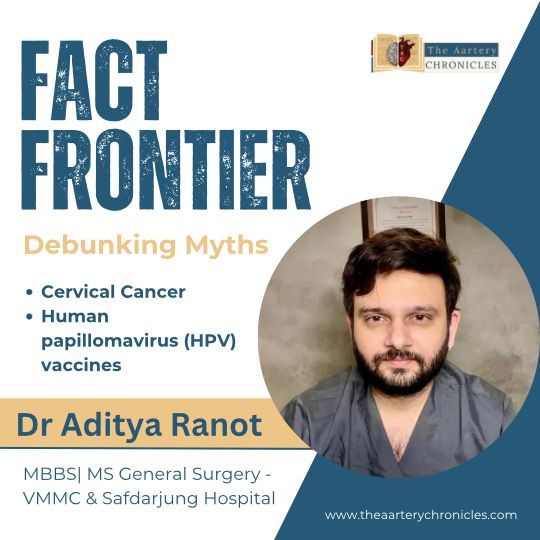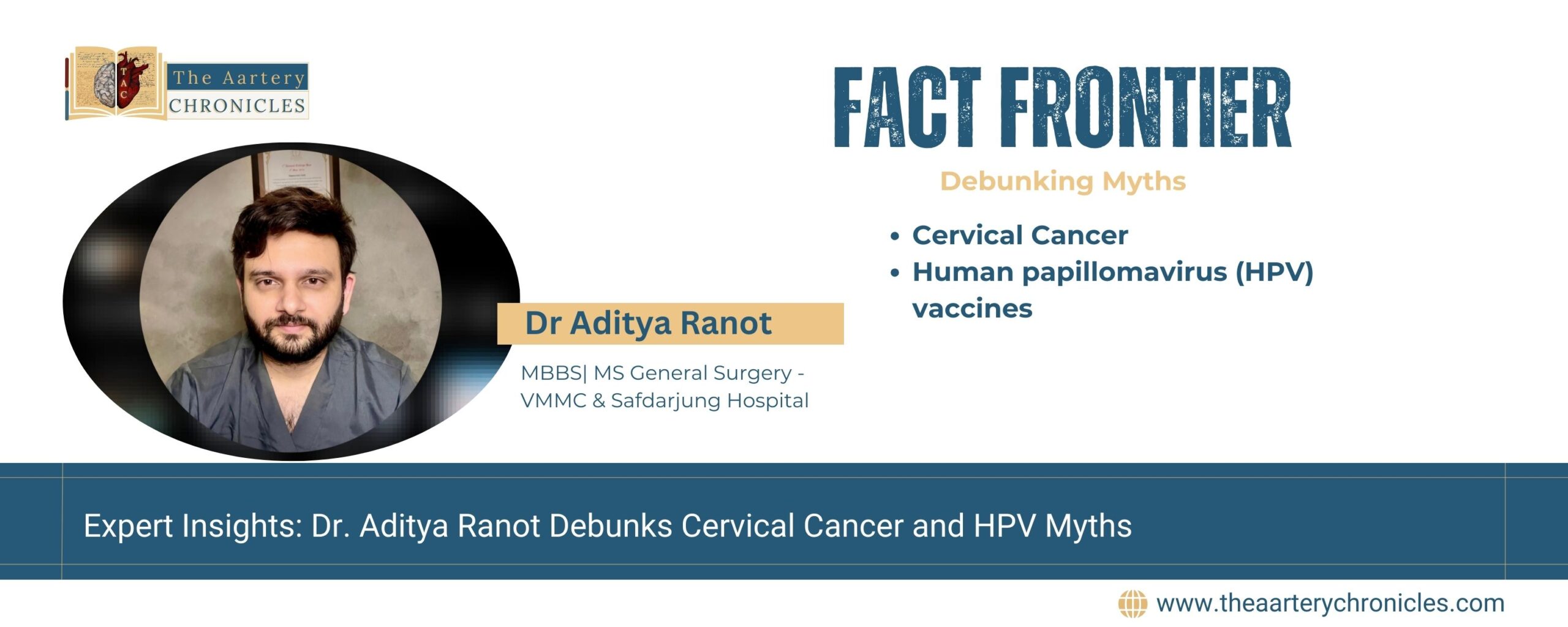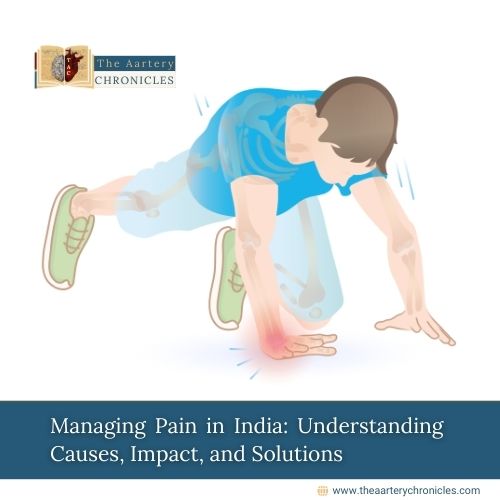

Expert Insights: Dr. Aditya Ranot Debunks Cervical Cancer and HPV Myths
Overview
Cervical cancer is a type of cancer that starts in the cells of the cervix, which is the lower part of the uterus connecting to the vagina. It usually develops gradually, beginning with precancerous changes in the cervix’s cells. Over time, these changes can turn into cancer if not detected and treated early. The most common cause of cervical cancer is infection with the human papillomavirus (HPV), a sexually transmitted virus.
Cervical cancer and human papillomavirus (HPV) are topics surrounded by numerous myths and misconceptions. These myths can lead to misinformation, unnecessary fear, delay in diagnosis, and prevent timely medical intervention.
In this article, Dr. Ranot a distinguished surgeon, pursuing MCH in oncology at VMMC and Safdarjung Hospital delves into some common myths and misconceptions surrounding cervical cancer, HPV infection, and the HPV vaccine. During the conversation with The Aartery Chronicles, Dr. Ranot addressed and debunked these myths to empower women with accurate information, encouraging them to take proactive steps in safeguarding their health through regular screenings and informed healthcare decisions.
Common Myths and Misconceptions About Cervical Cancer and HPV Infection
1. Myth: If you have HPV, you will definitely get cervical cancer.
Fact: Dr. Aditya Ranot addresses a common misconception that having an HPV infection automatically leads to cervical cancer. He clarifies that this is not true. Certain strains of HPV, specifically high-risk types like HPV-16 and HPV-18, increase the risk of developing cervical cancer, but not all HPV infections lead to cancer.
Dr. Ranot explains that the key factor is “persistent HPV infection,” which means the virus remains in the body over a long period, potentially leading to changes in the normal cells of the cervix. However, many HPV infections, particularly those caused by low-risk types such as HPV-6 and HPV-11, do not lead to cervical cancer. Instead, these strains might cause other conditions, such as genital warts, which can affect both men and women.
He emphasizes that a single HPV infection that is treated and cleared does not necessarily result in cervical cancer. It is crucial to understand that while HPV is a significant risk factor, not every infection will lead to cancer, and regular screenings can help manage and mitigate this risk.
2. Myth: A pelvic exam and a pap smear are the same thing.
Fact: Dr. Aditya Ranot clarifies a common misunderstanding that a pelvic examination and a pap smear are the same procedure. He explains that while both are essential components of women’s healthcare, they serve different purposes and are not identical.
Pelvic Examination vs. Pap Smear
Pelvic Examination: Dr. Ranot explains that pelvic examination involves the physical inspection of a woman’s reproductive organs. During this exam, a healthcare provider visually examines the external and internal genital areas, including the vaginal opening and conducts a manual inspection using their fingers to assess the health of the pelvic organs.
Pap Smear: On the other hand, a pap smear is a specific test that involves collecting cells from the cervix to examine under a microscope. During a pap smear, the doctor collects a sample of cells from any area of the cervix that appears suspicious. These cells are then stained and analyzed to check for abnormalities or signs of precancerous changes. The primary goal of a pap smear is to detect early signs of cervical cancer or other cellular abnormalities.
Dr. Ranot emphasizes that while a pelvic exam provides a general assessment of reproductive health, a pap smear is specifically focused on detecting cellular changes that could indicate cervical cancer. Understanding the distinction between these two procedures is important for ensuring that women receive appropriate and timely screenings.
3. Myth: Abnormal screening results mean you have cancer.
Fact: Dr. Aditya Ranot addresses a common misconception that abnormal screening results automatically indicate the presence of cancer. He emphasizes that this belief is not accurate and explains the nuances of cervical cancer screening.
Screening for cervical cancer typically involves
- Either an HPV test
- Or a pap smear
Both tests play crucial roles in detecting early signs of potential problems. If the HPV test indicates a human papillomavirus (HPV) infection, a pap smear is usually conducted to check for any cellular abnormalities in the cervix.
Dr. Ranot clarifies that an abnormal Pap smear result does not necessarily mean that cancer is present. In many cases, abnormal results may indicate pre-cancerous lesions rather than cancer itself. These lesions which are known as intraepithelial neoplasms or dysplasia, can vary in severity and be classified as low-grade, moderate, or high-grade.
- Low-grade dysplasia: Typically, no immediate treatment is required. Often, the body can clear the HPV infection over time, leading to the resolution of the abnormalities on its own.
- Moderate or high-grade dysplasia: These conditions may require treatment to prevent the progression to cervical cancer.
Dr. Ranot underscores the importance of regular screening, as it allows for the early detection and treatment of abnormalities before they develop into cancer. However, he reassures that an abnormal screening result should not cause immediate alarm, as it does not equate to a cancer diagnosis. Instead, it provides an opportunity for early intervention and prevention, significantly reducing the risk of cervical cancer.
4. Myth: The HPV vaccine causes infertility.
Fact: Dr. Aditya Ranot addresses this myth by clarifying that there is no scientific evidence to support the claim that the HPV vaccine leads to infertility.
Dr. Ranot emphasizes that the idea of HPV vaccination causing infertility is unfounded. Numerous studies and research articles have investigated this issue, and none have conclusively linked the vaccine to infertility. He reassures that HPV vaccination is safe and does not directly impact fertility.
However, Dr. Ranot notes that in some rare cases, infections that are not properly managed could potentially lead to complications that might affect fertility. For example, if an HPV infection is left untreated and spreads to the uterus, it could result in an infection of the fallopian tubes, leading to blockage. This scenario, however, is related to the progression of the infection itself and not the vaccination. Dr. Ranot further clarifies that the concern about infertility is more closely associated with sexually transmitted infections (STIs) such as chlamydia, which can occur alongside HPV. These infections, if left untreated, can lead to genital tract complications and, in rare cases, infertility. However, he emphasizes that this is not directly related to the HPV vaccine itself.
5. Myth: The HPV vaccine is only for young people.
Fact: A common misconception about the HPV vaccine is that it is only beneficial for young individuals. Dr. Aditya Ranot clarifies that while the vaccine is most effective when administered before the onset of sexual activity, it is not exclusively for the young.
Ideal Age for HPV Vaccine
Dr. Ranot explains that the ideal age for HPV vaccination is between 9 and 14 years. At this age, the vaccine is administered in two doses and offers the best protection because it is given before most individuals begin sexual activity. This early vaccination is crucial as it helps prevent HPV infections before any potential exposure to the virus.
Catch-Up HPV Vaccination for Ages 15 to 26
However, Dr. Ranot points out that the vaccine can still be beneficial for individuals beyond this age group. For those aged 15 to 26, a “catch-up” vaccination schedule is recommended, which involves three doses. This catch-up vaccination is effective in providing protection against HPV, even if the individual may have already been exposed to the virus.
For individuals aged 26 to 45, while the benefits of vaccination may decrease, the vaccine can still offer some level of protection. Dr. Ranot notes that although the risk-benefit ratio becomes less favorable with age, vaccination can still help control HPV infection to a certain extent. Therefore, the last recommended age for receiving the HPV vaccine is 45.
6. Myth: Condoms provide full protection against HPV.
Fact: Dr. Ranot explains that, contrary to popular belief, condoms do not offer full protection against HPV. While they are effective in significantly reducing the risk of transmission, they cannot guarantee complete protection.
The effectiveness of condoms in preventing HPV depends on various factors, including when and how the condom is used and whether it covers all potentially exposed areas.
Condoms are effective in lowering the risk of HPV transmission, especially in scenarios where the virus is spread from genital contact. However, they do not cover all areas where HPV can be transmitted, such as the regions not covered by the condom or during oral sex. Condoms help lower the chances of spreading HPV, especially during genital contact, but they do not eliminate the risk entirely. Understanding these limitations can help individuals make informed decisions about their sexual health and prevention strategies.
7. Myth: HPV can spread from skin-to-skin contact.
Fact: Dr. Ranot explains that contrary to the common notion, HPV does not spread through casual skin-to-skin contact. The virus requires specific conditions for transmission.
HPV is primarily transmitted through intimate contact involving mucous membranes. For example, it can spread through oral sexual activity if one partner has oral HPV. Research indicates that HPV can be transmitted from mouth to mouth in such cases. However, ordinary skin-to-skin contact does not facilitate the spread of HPV.
Conclusion
Understanding the facts about cervical cancer and HPV is crucial for effective prevention and treatment. Dispelling these myths helps individuals make informed decisions about their health, undergo timely screenings, and take preventive measures such as vaccination. By addressing these misconceptions, we can improve public awareness and reduce the impact of cervical cancer globally.
We extend our heartfelt thanks to Dr. Aditya Ranot for his invaluable insights and time in helping debunk these crucial myths about cervical cancer and HPV. His expertise greatly enriches our understanding of these important health issues.









